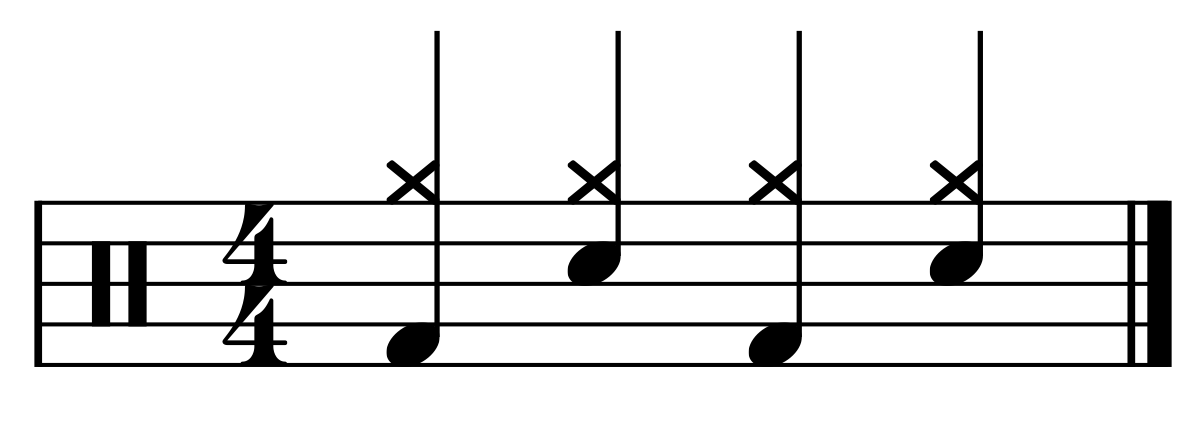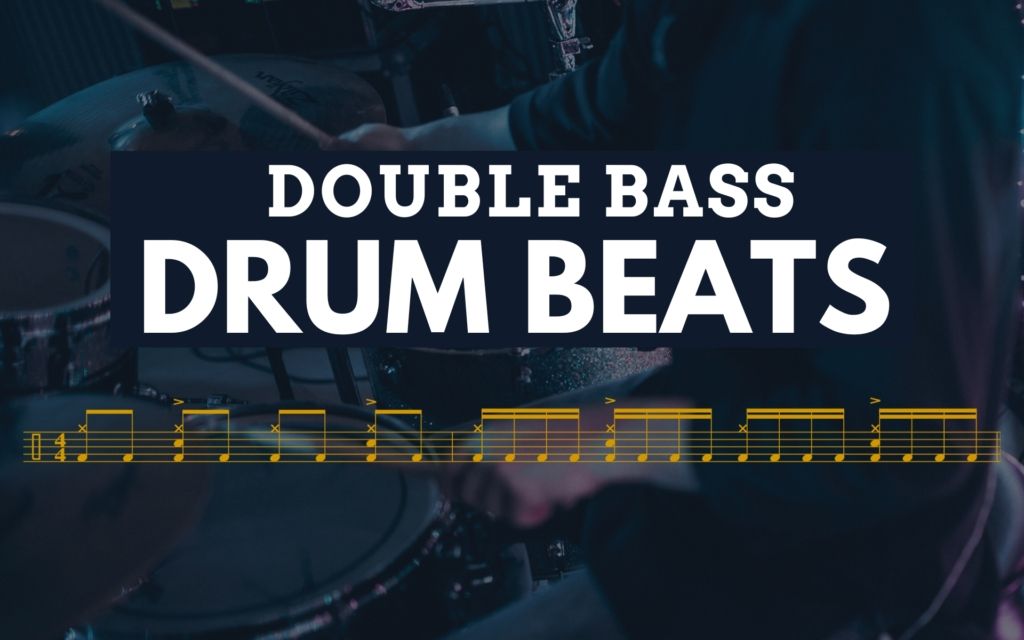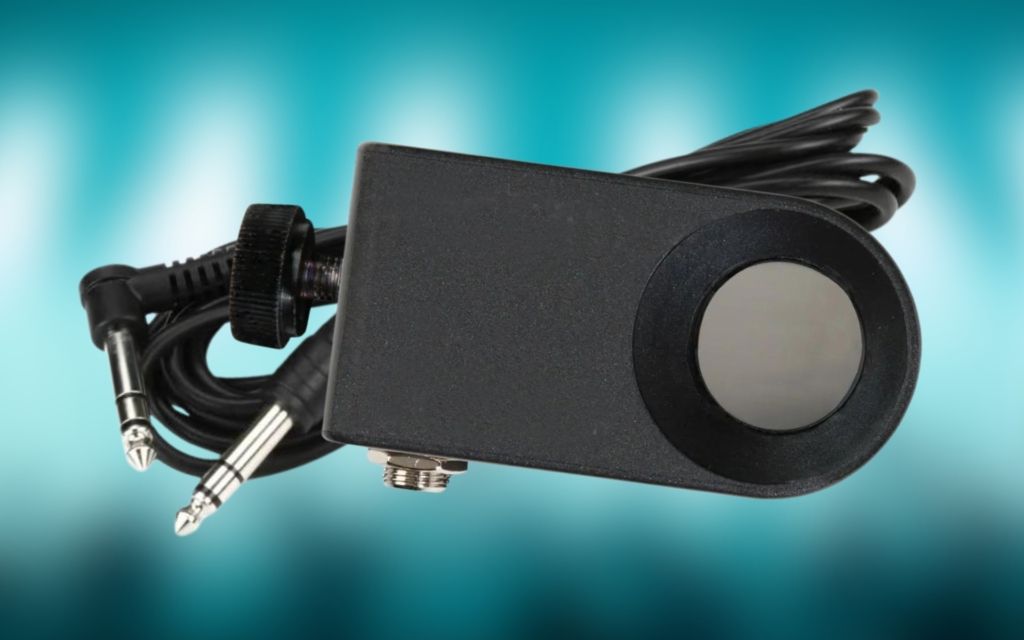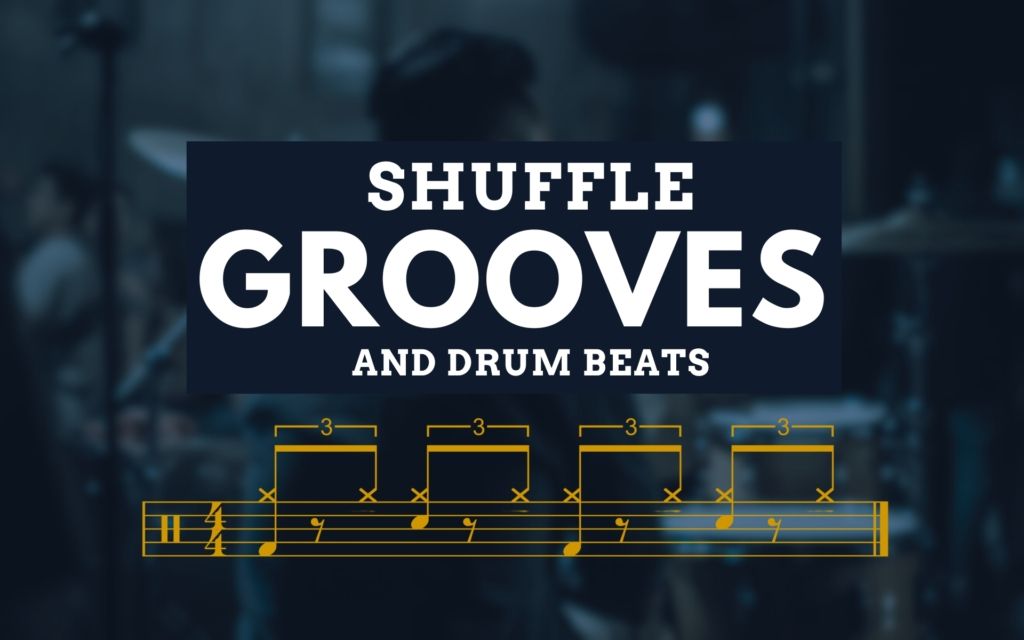In this guide, I will show you 15 basic drum beats for beginners, which will help you develop greater control of your hands and feet and enable you to develop valuable muscle memory that will allow patterns to feel natural and instinctive.
Learning to play the drums heavily relies on muscle memory, and this is developed by familiarizing yourself with how the separate actions all feel together, almost like clockwork!
Here are my top beginner drum beats to help you find your feet behind the drum set.
Contents
Basic Drum Beat 1

This is your very first beginner drum beat! This beat consists of quarter notes, and these are counted as ‘1, 2, 3, 4‘. Start off by using your right hand (assuming you are right-handed!) playing the hi-hat quarter notes.
Once you are playing them in time and they are evenly spaced out, go ahead and add in the kick drum on the ‘1‘ and ‘3‘ whilst keeping the quarter hi-hats going. Then finally add your left hand to play the snare drum ‘2‘ and ‘4‘, and there you go – your first simple drum beat!
Basic Drum Beat 2

his is one of the most common beginner drum beats, and it consists of eighth notes, which are counted as ‘1 & 2 & 3 & 4 &‘. It’s the classic ‘boots & cats’ sounding drum beat!
The kick and snare drums are in the exact same positions as the first drum beat, but now the hi-hat notes are eighth instead of quarter notes. So that means there is double the number of hi-hats in the same amount of bar space- because the note values half.
Basic Drum Beat 3

ext up we have a fun drum beat that lots of beginners might find tricky to grasp. This is because you will be used to the kick drum falling on the ‘1‘ and ‘3‘ of the bar. Now in this beginner drum beat, the kick falls on the ‘3 &‘.
Whilst playing this drum beat make sure to keep the hi-hats nice and consistent and don’t slow down when you get to the ‘3‘ and remember to push the kick back one eighth note to play this accurately.
Basic Drum Beat 4

This drum beat is reminiscent of the iconic ‘we will rock you‘ beat! The ‘boom boom clap‘ is ‘1 & 2‘ and ‘3 & 4‘ – with ‘kick kick snare’.
Keep a strong emphasis on the ‘2‘ and ‘4‘ with the snare drums to keep this drum beat driving forwards with energy.
Basic Drum Beat 5

Up next we have one of the most popular basic drum beats that should feel pretty natural to play once you have gotten to grips with all the previous beginner drum beats.
With the hi-hats and snares staying in exactly the same positions (straight hi-hat eighth notes and snares on ‘2‘ and ‘4‘; the kicks are now falling on the ‘1‘ and ‘2 &‘ and ‘3‘.
Basic Drum Beat 6

This is a beginner drum beat that will develop your consistency and timekeeping. The kick drums fall on even quarter notes – ‘1, 2, 3, 4‘. Keep this beat sounding nice and tight, and make sure the kick drums are locked in tightly with the hi-hats and also the snare drums when they all fall into place together.
On the ‘2‘ and ‘4‘ the kick drum, snare drum, and hi-hat all land together, so make sure it sounds like one precise hit. You do not want it to sound messy, with multiple surfaces all being hit at slightly different times.
Basic Drum Beat 7

So far all of these basic drum beats for beginners feature snare drum hits that fall precisely on the ‘2‘ and ‘4‘. This is your typical rock backbeat and it’s very popular in modern music. But to help develop your left-hand control, you’re now going to be playing more snare drum hits. You’ll be playing snare drums on evenly spaced quarter notes – ‘1, 2, 3, 4‘.
There are two kick drum hits in the bar and these both fall in and’s. The initial kick drum falls on ‘1 &‘ and then on ‘3 &‘.
This drum beat might feel awkward at first but practice it slowly and make sure each snare and kick drum hits sound in time with the accompanying hi-hat notes.
Basic Drum Beat 8

Now once you have familiarized yourself with the quarter note snare drum hits, you will now be mixing things up by playing a combination of kick drums around the snare drum hits.
The kick drums fall on the ‘1‘, ‘2‘, ‘3 &‘ and ‘4 &‘. Make sure to play the snare drums with lots of emphasis to keep the beat driving forwards and ensure the beat feels solid throughout. The second half of the bar should sound like four clean hits with ‘3 & 4 &‘!
Basic Drum Beat 9

ow we have familiarized ourselves with eighth notes in a bar, it’s time to look at sixteenth notes! There are twice as many semiquavers as there are quavers in the same amount of bar, because the note values half, and they therefore occur twice as often. To count the sixteenth note hi-hats it will sound like ‘1, e, &, a, 2, e, &, a, 3, e, &, a, 4, e &, a’
Use both hands on the hi-hat to play single strokes – right, left, right, left etc, following the sticking pattern above the stave. Ensure to play them so that they sound really clean and tight! The kick drums will be straight quarter notes counted as ‘1, 2, 3, 4‘.
Basic Drum Beat 10

Lastly, once you have grasped the sixteenth note hi-hats, you can look to include snare drums on the rock backbeat – falling on the ‘2‘ and ‘4‘. You will want to retract your right hand and pull it away from the hi-hat to play the corresponding snare drum hit, before returning it to the hi-hat to perform the sixteenth note pattern.
Once you have got a hang of playing the snare drums within the sixteenth note hi-hat pattern, you can begin to include the bass drums that fall on the ‘1‘, ‘2 &‘ and ‘3‘.
Basic Drum Beat 11

This next drum beat is quite simple in theory, but it can be tricky to get a grip on. You’re going to play the same basic rock beat that we learned earlier for beat two.
The difference here is that you’re going to accent all the offbeats on the hi-hat. That means that you’re going to play the hi-hat louder on every “and”.
It helps to strike the hi-hats on the edge, as that naturally gives a louder sound.
Basic Drum Beat 12

In this groove, you’re going to play what is known as a ghost note on the snare drum. Ghost notes are soft strokes that add a bit of dynamic texture to drum beats.
The ghost note will fall on the “a” of beat two. So, you’re going to count in sixteenth notes so that you know exactly where that ghost note will land.
Try to make the ghost note as soft as you can. The best way is to drop your wrist to play it, instead of lifting your wrist like you would to play stronger snare drum notes.
Basic Drum Beat 13

We’re also going to play an offbeat stroke in this drum beat. But this time, it’s going to be played on the bass drum.
Separating your hands and feet can be quite tricky when you first learn how to play drum beats, so a groove like this is perfect for working on that skill.
The offbeat bass drum note falls on the “a” of beat one. You’ll then play straight eighth notes for the rest of the drum beat.
Basic Drum Beat 14

This beat is commonly known as a disco beat. It seems tricky when you first look at it, but it’s actually quite easy to play.
You’re going to play the same beat as beat six on this list. The added part is to open your hi-hat on all the offbeats.
To make it easier, just stomp your feet on the pedals at the same time for all the onbeats, and then that open hi-hat should come out naturally.
Basic Drum Beat 15

This final beat has you playing two consecutive bass drums followed by two consecutive snare drums. It’s one of the easier beats to learn, but it’s good for developing your ability to play repeating strokes on the same drums.
Learning Your First Basic Drum Beats
Starting your drumming journey is both exciting and challenging. There are a lot of unfamiliar aspects of drumming to get to grips with.
Not just learning technique and how to control your hands and feet, but also knowing which parts of the drum set to play when playing your first basic drum beats before moving into learning your first drum fills!
If you haven’t already got a Drumeo membership, I’d recommend taking advantage of their amazing platform, which features thousands of high-quality lessons from some of the best drummers on the planet! You can sign up for a free 30-day trial below.

For most new drummers, the most challenging part of learning to play the drums is developing limb independence, or in other words, getting both hands and both feet to play all together in time!
Whilst practicing these basic drum beats, make an effort to practice at a slow tempo and to slowly build it up as you find yourself more confident at playing them. Remember, don’t run before you can walk!
It might take you longer to grasp some of these beginner drum beats than others, so try as best as possible to be patient with yourself and remember it’s okay to not get things quite right the first time.
Remember to practice these basic drum beats with a metronome to keep even dynamics throughout, and keep rhythms tight and compact, with minimal tempo fluctuations!









